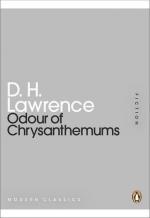|
This section contains 372 words (approx. 1 page at 400 words per page) |

|
Odour of Chrysanthemums Summary & Study Guide Description
Odour of Chrysanthemums Summary & Study Guide includes comprehensive information and analysis to help you understand the book. This study guide contains the following sections:
This detailed literature summary also contains Bibliography on Odour of Chrysanthemums by D. H. Lawrence.
"Odour of Chrysanthemums," regarded as one of D. H. Lawrence's most accomplished stories, was written in 1909 and published in Ford Madox Hueffer's English Review in June, 1911. A different version, which transformed and expanded the concluding section in which Elizabeth Bates reflects on her married life in the presence of the body of her husband, was published in 1914 in The Prussian Officer and Other Stories. The story's controlled analysis of the harsh industrial setting and of Eliza-beth Bates's psychological transformation has been widely admired. H. E. Bates has even argued that Lawrence's greatest achievement is his short fiction.
The story's evolution in its three major versions has been examined by a number of critics. The final version's unsentimental and highly judgmental condemnation of Elizabeth Bates for the failure of her marriage has been related to Lawrence's liberation from the influence of his beloved mother upon her death in 1910. The story is frequently compared to Sons and Lovers, a largely autobiographical novel, in which Lawrence explores his parents' conflicted relationship. As in "Odour of Chrysanthemums," an inarticulate, drink-obsessed miner in Sons and Lovers is disparaged by his wife who longs for a more genteel life. The harsh, bleak mining villages of Nottinghamshire, which Lawrence knew so well, are powerfully evoked in "Odour of Chrysanthemums" and contrasted with the unfettered beauties of the natural world.
When Lawrence's editor at the English Review, Ford Madox Hueffer, first read "Odour of Chrysanthemums," he considered it a work of genius, but it did not prevent him from demanding a cut of five pages. The story was one of Lawrence's first and it underwent two major revisions before it appeared in its final form in The Prussian Officer and Other Stories.
Hueffer (a distinguished author in his own right, who is better known as Ford Madox Ford) was immediately struck by Lawrence's title, which he describes as "at once a challenge and an indication. The author seems to say: Take it or leave it. You know at once that you are not going to read a comic story about someone's butler's omniscience. The man who sent you this has, then, character, the courage of his convictions, a power of observation. All these presumptions flit through your mind."
Read more from the Study Guide
|
This section contains 372 words (approx. 1 page at 400 words per page) |

|



